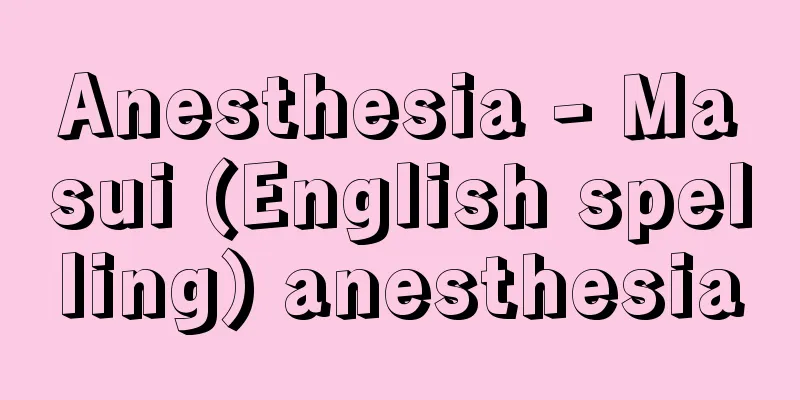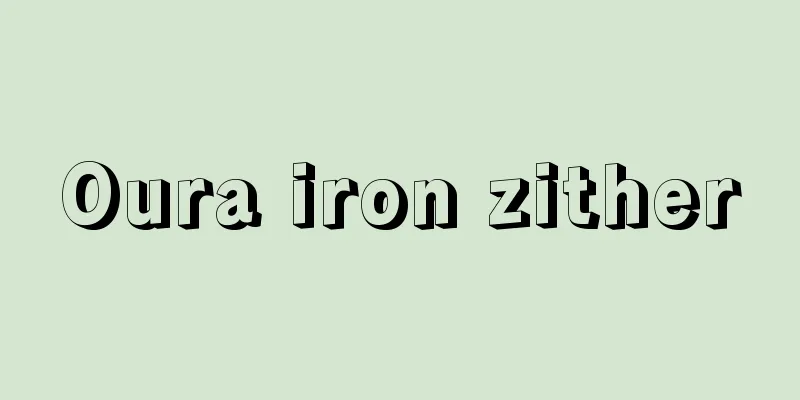Anesthesia - Masui (English spelling) anesthesia

|
Generally, it means the temporary elimination of the sensation of pain. However, the field of anesthesiology is not just about eliminating pain, but is a science that deals with the overall management of patients, mainly during surgery, and the concept of anesthesia has become quite broad. In other words, anesthesia requires detailed knowledge of anesthetic drugs, as well as broad knowledge of blood transfusions, fluid infusions, and the management of patients' breathing and circulation. A doctor who specializes in such knowledge and techniques is called anesthesiologist. Currently, the fields in which anesthesiologists work include anesthesia for surgery and examinations, management of seriously ill patients in intensive care units (ICUs), pain treatment in pain clinics, and emergency resuscitation, and are not limited to the operating room alone. [Hideo Yamamura and Yoshitsugu Yamada] History of AnesthesiaIn ancient times, pain was thought to be the work of the devil. To drive away the devil, exorcists and shamans played the role of exorcists. Later, to relieve pain, people would drink decoctions of plants such as henbane, poppy, mandala, and cannabis, or alcohol. This method has been used all over the world for a long time, and in Japan in 1804 (Bunka 1), Hanaoka Seishu used Tsusensan (a herbal medicine) to anesthetically treat a breast cancer operation. However, this type of anesthetic method had a major drawback in that the length and depth of the anesthesia could not be freely adjusted. This led to the development of inhalation anesthesia, which is more easily adjustable. As for inhalation anesthesia, nitrous oxide anesthesia was introduced by the American dentist Wells in 1845, followed by ether anesthesia by another American dentist, Morton, in 1846, and in England, chloroform anesthesia was introduced by John Snow (1813-85) in 1847. Since then, inhalation anesthesia has made remarkable developments, and today anesthesia is performed using safer anesthetics, sophisticated anesthesia machines, and devices that monitor the patient's condition. Anesthesia can be broadly divided into general anesthesia and local anesthesia. General anesthesia is anesthesia that causes loss of consciousness, while local anesthesia anesthetizes a part of the body by blocking the transmission of nerves related to the treatment area, so the patient does not lose consciousness. However, things like acupuncture anesthesia do not fall into either category. [Hideo Yamamura and Yoshitsugu Yamada] General anesthesiaAnesthetic drugs administered in some way are carried by the blood and act on the brain. This reduces brain function, causing loss of consciousness and resulting in an anesthetized state. This is called general anesthesia, but it can be classified into inhalation anesthesia, intravenous anesthesia, rectal anesthesia, etc. depending on the method of administration of the anesthetic drug. [Hideo Yamamura and Yoshitsugu Yamada] Inhalation anesthesiaThis is a method of inhaling an anesthetic, and gas or volatile anesthetics are used. These dissolve in the blood from the alveoli and are transported to the brain, causing an anesthetized state. Inhalation anesthesia maintains anesthesia as long as the anesthetic is inhaled, and the depth of anesthesia can be adjusted by changing the concentration of the anesthetic. In addition, it is considered the safest method of anesthesia because the patient can recover from anesthesia immediately by stopping inhalation. An anesthesia machine is generally used to inhale an anesthetic. An anesthesia machine consists of a part that supplies the anesthetic and a part that allows the patient to inhale it. The anesthetic is supplied at the desired concentration by a flow meter for various gases such as oxygen, or by a vaporizer for volatile gases. The part that inhales the anesthetic consists of a breathing circuit, a rubber bag, and a carbon dioxide gas absorption device, and is not only used to inhale gas, but also to help the patient breathe during anesthesia and perform artificial respiration. Common inhalational anesthetics include: (1) Ether Properly called ethyl ether, anesthesia can be maintained by inhaling a concentration of 3-5%. During anesthesia, there are no significant changes in breathing or blood pressure, and the risk of arrhythmia is low. It only breaks down to a few percent in the body, making it a very safe anesthetic. However, it has some drawbacks, such as irritating the airways and increasing saliva and airway secretions, slow induction of anesthesia and awakening, and frequent post-anesthesia nausea and vomiting. In addition, it is flammable, so it has now been replaced by non-flammable anesthetics (halothane, isoflurane, sevoflurane, etc.). (2) Halothane ("Flothane") A fluorinated hydrocarbon that is non-flammable, anesthesia can be maintained by inhaling around 1%. Anesthesia is induced and awakened quickly, and there is no irritation to the airways. However, it is prone to respiratory depression and a drop in blood pressure, and arrhythmia is not uncommon. This frequency increases significantly when used in combination with adrenaline. Halothane can rarely cause liver damage, but this is more likely to occur in people who have been given halothane repeatedly. Also, 18% of halothane is broken down in the body, and it is believed that the products of this breakdown are related to liver damage. (3) Enflurane (Ethren) It has properties very similar to halothane, is non-flammable, and induces and recovers from anesthesia quickly. Its advantages over halothane include being less likely to cause arrhythmia when used in combination with adrenaline, and not causing liver damage, which is thought to be related to the fact that only 2.4% of it breaks down in the body. Its disadvantages include a weaker anesthetic power than halothane (about half the strength), and the possibility of causing convulsions if the anesthesia is too strong. Enflurane is not currently used in clinical practice. (4) Isoflurane (Folane) It is an isomer of enflurane, but it is not flammable and induction and recovery from anesthesia are as quick as enflurane. It breaks down in the body at 1/10th the rate of enflurane and 1/100th the rate of halothane, and it does not damage the liver or kidneys. It has a relatively strong muscle relaxant effect. (5) Sevoflurane (Sevofurane) Anesthesia induction and recovery are very fast, and the depth of anesthesia can be rapidly changed by adjusting the inhalation concentration. Its anesthetic potency is weaker than that of halothane. It has many advantages, such as being less likely to cause arrhythmia when used in combination with adrenaline, but its disadvantage is that it produces decomposition products when it comes into contact with soda lime. However, this does not pose a problem in clinical use. It decomposes in the body at about 3%, producing inorganic fluoride, but this is not in a quantity that would cause kidney damage, so it is said to be safe. (6) Laughing Gas (Nitrous Oxide) A widely used gas anesthetic that is always mixed with oxygen before inhalation. Its anesthetic power is weak, and even a 50% concentration is not enough to make the patient unconscious. However, it does have an analgesic effect, so it is sometimes used in dental treatment and painless childbirth. To induce general anesthesia using nitrous oxide alone, a concentration of 80% or more is required, but this does not allow for sufficient oxygen to be delivered. Therefore, nitrous oxide is rarely used alone, and is usually used in combination with other anesthetics. [Hideo Yamamura and Yoshitsugu Yamada] Intravenous anesthesiaThis is a method of achieving general anesthesia by injecting an anesthetic into a vein. The injected anesthetic is immediately transported to the brain and exerts its anesthetic effect, but in order to wake the patient up from anesthesia, it is necessary to wait until the concentration of the anesthetic in the brain has decreased. Therefore, drugs with a short duration of action are generally used. The intravenous anesthetics currently in use, except for ketamine, have no analgesic effect, and all of them have respiratory depressant effects. For this reason, they are rarely used alone, but are often used as an induction for inhalation anesthesia, or in combination with nitrous oxide anesthesia, inhalation anesthesia, or narcotic analgesics. Total intravenous anesthesia is a general anesthesia method in which all drugs necessary for anesthesia are administered intravenously. In other words, it is a method in which a combination of hypnotics, analgesics, and muscle relaxants are administered. Propofol is the preferred hypnotic drug because it has a short duration of action and is highly adjustable. It remains to be seen whether this method is superior to conventional inhalation anesthesia. The main intravenous anesthetics are listed below. (1) Thiopental ("Lavonal"): It has a strong drowsiness-inducing effect and its duration of action is relatively short. However, repeated use has a cumulative effect, which extends the duration of action and causes a hangover-like state even after waking. (2) Ketamine (Ketalar) This is the only intravenous anesthetic with analgesic properties. It suppresses breathing less than thiopental, and blood pressure actually increases. It is administered intravenously as well as intramuscularly. The drawback of this drug is that it can cause hallucinations and excitement when waking up from anesthesia, and it often leads to dreaming while under anesthesia. Therefore, it is rarely used alone in adults, but is sometimes used in children. (3) Propofol (Diprivan) It is characterized by a short duration of anesthesia, rapid recovery from anesthesia, and minimal nausea or vomiting. For this reason, it is administered using a continuous infusion device. It has almost no analgesic effect, so it must be used in combination with an analgesic. When the drug is injected, blood pressure may drop and vascular pain may occur. It is suitable for outpatient anesthesia. (4) Neuroleptoanalgesia (NLA) This is a special anesthetic method that combines a strong psychotropic drug (sedative) with an analgesic to achieve deep sedation and strong analgesia. This method was designed to allow surgery without losing consciousness, and is known as "general anesthesia without sleep." The drugs used are droperidol (DPL) for psychotropic drugs and fentanyl (FNL) for analgesics, both of which are injected intravenously. This method is possible for minor surgeries, but not for major surgeries, so in major surgeries it is used in combination with inhalation anesthesia using nitrous oxide. Since the patient loses consciousness when inhaling nitrous oxide, this combined anesthesia method is called neuroleptoanalgesia (NLA-nitrous oxide combined anesthesia). [Hideo Yamamura and Yoshitsugu Yamada] Rectal anesthesiaWhen an anesthetic is injected into the rectum, it is absorbed and general anesthesia is obtained. In the past, thiopental was used as the drug, but now diazepam is used. Since it cannot be adjusted, it is only used as a sedative method for children during examinations. [Hideo Yamamura and Yoshitsugu Yamada] Local anesthesiaThis method involves administering a local anesthetic to a peripheral nerve to anesthetize the area controlled by that nerve, and is divided into the following types depending on the area where the drug is injected: [Hideo Yamamura and Yoshitsugu Yamada] Spinal anesthesiaThis is a method of anesthetizing the lower body by injecting a local anesthetic into the subarachnoid space. It is officially called spinal subarachnoid anesthesia. The spinal cord is covered in the order pia mater, arachnoid mater, and dura mater, with the space between the pia mater and arachnoid mater being the subarachnoid space. Spinal anesthesia is used for anesthesia in surgery on the lower abdomen and lower limbs, and can provide muscle relaxation, anesthesia, and intestinal contraction. However, it has drawbacks such as a drop in blood pressure, nausea, vomiting, and post-anesthesia headaches. [Hideo Yamamura and Yoshitsugu Yamada] Epidural anesthesiaThis method involves injecting a local anesthetic into the epidural space, where it anesthetizes the nerves entering and exiting the spinal cord, and can be used to anesthetize any part of the body below the neck. In addition to being used as anesthesia for general surgery, it is also widely used in pain clinics. [Hideo Yamamura and Yoshitsugu Yamada] Nerve blocksA local anesthetic is injected into the nerve trunk to block nerve transmission, providing anesthesia to the area controlled by that nerve. Nerve blocks are widely used to treat neuralgia and other chronic pain conditions, rather than as anesthesia during surgery. [Hideo Yamamura and Yoshitsugu Yamada] Infiltration anesthesiaThis method involves injecting a local anesthetic directly into the area where the skin incision will be made. [Hideo Yamamura and Yoshitsugu Yamada] Topical anesthesiaThis method involves applying or spraying a local anesthetic to the mucous membranes of the nasal cavity, oral cavity, pharynx, larynx, esophagus, eyes, etc. to anesthetize the area. When local anesthetics act on nerves, they block nerve transmission at that site, but this action must be reversible. Currently widely used anesthetics include cocaine, procaine, lidocaine, mepivacaine, bupivacaine, ropivacaine, and dibucaine. Each of these has a different duration of action and toxicity, but some are broken down in the blood and others in the liver. Furthermore, if used in large quantities, they can cause symptoms of poisoning, such as excitement, generalized convulsions, a drop in blood pressure, and cardiac arrest. [Hideo Yamamura and Yoshitsugu Yamada] Complications of anesthesiaThere are various types of accidents that can occur during anesthesia, but the main ones are as follows: (1) Respiratory system complications include airway obstruction, oxygen deficiency due to respiratory depression, carbon dioxide accumulation, postoperative apnea, pneumonia, and atelectasis (pulmonary expansion failure), as well as laryngitis and hoarseness associated with the use of an endotracheal tube. (2) Symptoms related to the circulatory system include cardiac arrest, arrhythmia, bradycardia, tachycardia, hypertension, and hypotension. Other symptoms include shock due to bleeding, side effects of blood transfusions, and pulmonary edema caused by heart failure or massive fluid transfusions. (3) Other than respiratory and circulatory system complications, there are postoperative oliguria, anuria, vomiting, nerve paralysis of the limbs caused by unnatural positioning during surgery, and transient postoperative mental disorders seen in elderly people. Malignant hyperthermia is extremely rare, but is one of the most dangerous complications. After the start of anesthesia, body temperature rises rapidly. In the past, many patients died from this condition, but in recent years, the survival rate has improved. It is thought to be caused by muscle abnormalities in the patient, and it often occurs in families. In addition, when flammable inhalation anesthetics such as ether and cyclopropane were used, there was a risk of ignition and explosion due to static electricity, but these flammable drugs are rarely used today, so there is no need to take special care. [Hideo Yamamura and Yoshitsugu Yamada] [Reference items] | | | | | | | | | | | | |Source: Shogakukan Encyclopedia Nipponica About Encyclopedia Nipponica Information | Legend |
|
一般的には痛みの感覚を一時的に除去することを意味する。しかし、麻酔学といわれる分野が、単に痛みを除くということばかりではなく、手術を中心とした患者の全身管理を行う学問となっているように、麻酔の概念もかなり広くなっている。すなわち、麻酔には麻酔薬についての細かい知識が必要とされるほかに、輸血、輸液、患者の呼吸や循環の管理についての広い知識が要求されているのである。そして、このような知識と技術とを専門分野とする医師を麻酔科医とよんでいる。現在、麻酔科医の活動している分野には、手術や検査のための麻酔、集中治療施設(ICU)における重症患者の管理、ペインクリニックでの痛みの治療、救急蘇生(そせい)などがあり、単に手術室だけにとどまらず、幅広いものとなっている。 [山村秀夫・山田芳嗣] 麻酔の歴史古代においては、痛みは悪魔のしわざと考えられていた。そしてこれを追い払うために魔除(まよ)けや祈祷(きとう)師がその役を演じた。その後、痛みをとるためにヒヨス、ケシ、マンダラゲ、大麻などの植物を煎(せん)じて飲ませたり、アルコールを飲ませる方法が用いられた。このような方法は世界各地でかなり昔から行われており、日本でも1804年(文化1)に華岡青洲(はなおかせいしゅう)が通仙散(麻沸散)を用いて麻酔をし、乳癌(がん)の手術をしている。しかし、このような麻酔法は麻酔の長さや深さを自由に調節することができないという大きな欠点があった。そこで、より調節性のよい吸入麻酔が登場することになる。 吸入麻酔は、1845年アメリカの歯科医師ウェルズにより笑気麻酔が、また1846年同じくアメリカの歯科医師モートンによりエーテル麻酔が始められ、イギリスでは1847年にスノーJohn Snow(1813―85)によりクロロホルム麻酔が始められた。その後の吸入麻酔の発展は目覚ましいものがあり、今日では、より安全な麻酔薬、精密な麻酔器とともに、患者の状態監視装置も駆使されて麻酔が行われている。 麻酔は全身麻酔と局所麻酔とに大別される。全身麻酔とは意識のなくなる麻酔であり、局所麻酔とは、治療部位に関係する神経の伝達を妨げることにより、体の一部を麻酔するもので、意識を失うことはない。しかし、鍼(はり)麻酔のようなものは、このいずれにも入らない。 [山村秀夫・山田芳嗣] 全身麻酔なんらかの方法で投与された麻酔薬は、血液によって運ばれ、脳に作用する。このため、脳の機能が低下して意識が失われ、麻酔状態が得られる。これを全身麻酔というが、麻酔薬の投与の方法によって吸入麻酔、静脈麻酔、直腸麻酔などに分類される。 [山村秀夫・山田芳嗣] 吸入麻酔麻酔薬を吸入させる方法であり、ガスか揮発性の麻酔薬が用いられる。これらのものは肺胞から血液中に溶け、脳に運ばれて麻酔状態をおこす。吸入麻酔では、麻酔薬を吸入している限り麻酔が維持できるし、吸入の濃度を変えることによって、麻酔の深さを調節することができる。また、吸入を止めればすぐに麻酔から覚ますことができるので、もっとも安全な麻酔法とみなされている。麻酔薬を吸入させるには一般に麻酔器が用いられる。麻酔器は、麻酔薬を供給する部分と、それを患者に吸入させる部分からなっている。麻酔薬の供給は、酸素をはじめとする種々のガスの場合は流量計によって、また、揮発性の場合は気化器によって、希望する濃度を正確に送ることができる。麻酔薬を吸入させる部分は、呼吸回路、ゴム嚢(のう)、および炭酸ガス吸収装置などからなっており、単にガスを吸入させるばかりではなく、麻酔中に患者の呼吸を助けたり、人工呼吸をすることもできるようになっている。 吸入麻酔薬の代表的なものに次のようなものがある。 (1)エーテル 正しくはエチルエーテルというが、3~5%の濃度を吸入させることで麻酔を維持することができる。麻酔中は、呼吸や血圧に大きな変化はなく、不整脈のおこる危険も少ない。体内での分解も数パーセントであり、安全性の高い麻酔薬である。しかし、気道を刺激して唾液(だえき)や気道分泌を増すこと、麻酔の導入や覚醒(かくせい)が遅いこと、麻酔後の悪心(おしん)や嘔吐(おうと)が多いことなどの欠点があるほか、引火性であるため、現在では、引火性のない麻酔薬(ハロタン、イソフルラン、セボフルランなど)にかわっている。 (2)ハロタン(「フローセン」) フッ素の入った炭化水素であり、引火性はなく、1%前後の吸入で麻酔が維持できる。麻酔の導入や覚醒も速やかであり、気道への刺激もない。しかし呼吸抑制、血圧の低下をおこしやすく、不整脈もまれではない。ことにアドレナリンと併用すると、その頻度は著しく増加する。ハロタンはまれに肝障害をおこすことがあるが、これは、ハロタンを繰り返し与えられた人におきやすい。また、ハロタンは18%が体内で分解されるが、その分解産物が肝障害と関係すると考えられている。 (3)エンフルラン(「エトレン」) ハロタンとよく似た性質を有し、引火性はなく、麻酔の導入や覚醒も速やかである。ハロタンよりも優れている点は、アドレナリンと併用しても不整脈をおこしにくいこと、肝障害をおこさないことなどで、これは体内での分解が2.4%と少ないことが関係しているものと思われる。欠点としては、ハロタンよりも麻酔力が弱い(約2分の1である)こと、麻酔が深いとけいれんをおこすことがあるなどである。エンフルランは現在臨床では使われていない。 (4)イソフルラン(フォーレン) エンフルランと異性体であるが、引火性はなく麻酔の導入や覚醒はエンフルラン同様速やかである。体内での分解はエンフルランの10分の1、ハロタンの100分の1と小さく、肝臓、腎(じん)臓に対する障害はない。比較的強い筋弛緩(しかん)作用がある。 (5)セボフルラン(セボフレン) 麻酔の導入および覚醒は非常に速く、吸入濃度の調節によって麻酔深度を急速に変えることができる。ハロタンに比べ麻酔力価は弱い。アドリナリンと併用しても不整脈をおこしにくいなど、多くの利点があるが、欠点としてはソーダライムと接触した場合分解産物を生ずる。しかし、これは臨床的使用では問題ない。体内での分解は約3%で無機フッ素が出るが、腎障害をおこす量ではないので安全であるといわれている。 (6)笑気(亜酸化窒素) 広く用いられているガス麻酔薬で、かならず酸素と混合して吸入させる。麻酔力は弱く、50%の濃度でも患者の意識をなくすことはできない。しかし、鎮痛作用は得られるので、これを歯科治療や無痛分娩(ぶんべん)に用いることがある。笑気のみで全身麻酔をするには80%以上の濃度が必要となるが、これでは酸素を十分に与えることができない。したがって、笑気は単独で用いられることは少なく、他の麻酔薬と併用するのが普通である。 [山村秀夫・山田芳嗣] 静脈麻酔麻酔薬を静脈内に注入することによって全身麻酔を得る方法である。注入された麻酔薬はただちに脳に運ばれて、麻酔効果を発揮するが、麻酔から覚ますためには、脳に作用している麻酔薬の濃度が減るまで待たなければならない。したがって、一般に作用時間の短い薬が用いられる。現在使用されている静脈麻酔薬は、ケタミンを除いては鎮痛効果はなく、またすべての薬に呼吸抑制作用がある。このため単独で用いられることは少なく、吸入麻酔の導入として、あるいは笑気麻酔や吸入麻酔、あるいは麻薬性鎮痛薬と併用して用いられることがしばしばある。 また、全静脈麻酔とは、麻酔に必要な薬をすべて静脈内に投与して行う全身麻酔法である。すなわち催眠薬、鎮痛薬、筋弛緩薬を組み合わせて投与する方法である。催眠薬としてプロポフォールが好んで用いられるが、これは、作用期間が短いため、調節性に優れていることによる。この方法が従来の吸入麻酔に比べて優れているかどうかは、今後の成り行きをみなければわからない。静脈麻酔薬のおもなものを次にあげる。 (1)チオペンタール(「ラボナール」) 強い睡眠作用を有し、作用時間は比較的短い。しかし、繰り返して用いると蓄積作用があるため、作用時間も延長し、覚醒しても二日酔いのような状態がおこる。 (2)ケタミン(「ケタラール」) 唯一の鎮痛作用のある静脈麻酔薬である。呼吸の抑制はチオペンタールより少なく、血圧はむしろ上昇する。静脈内ばかりでなく、筋肉内注入も行われる。本薬の欠点は、麻酔からの覚醒時に幻覚や興奮をおこすことであり、麻酔中も夢をみることが多い。したがって、成人では単独で用いられることは少ないが、小児ではときどき用いられる。 (3)プロポフォール(ディプリバン) 麻酔の時間が短く、麻酔からの覚醒が速やかで、悪心や嘔吐も少ないのが特長である。このために使用は持続注入器を用いて行う。鎮痛作用はほとんどないので鎮痛薬との併用を必要とする。薬の注入時には血圧が下がったり、血管痛をおこすことがある。外来の麻酔には適している。 (4)ニューロレプトアナルゲジア(NLA) 強力な向精神薬(鎮静薬)と鎮痛薬とを組み合わせて、深い鎮静状態と強い無痛状態を得る特別な麻酔方法である。これは、意識を消失させることなしに手術をするために考えられた方法で、「眠りなき全身麻酔」として知られる。使用する薬としては、向精神薬にはドロペリドール(DPL)、鎮痛薬にはフェンタニール(FNL)が代表的なものであるが、これらはいずれも静脈内に注入される。この方法での小手術は可能であるが、大手術は無理なため、大手術の際は笑気の吸入麻酔と併用する。笑気の吸入によって患者の意識はなくなるので、この併用による麻酔法をニューロレプト麻酔(NLA‐笑気併用麻酔)とよんでいる。 [山村秀夫・山田芳嗣] 直腸麻酔麻酔薬を直腸内に注入すると、ここから吸収されて全身麻酔が得られる。使用する薬としては、昔はチオペンタールが用いられたが、現在ではジアゼパムが用いられる。調節性がないので、小児の検査時の鎮静法として用いられるにすぎない。 [山村秀夫・山田芳嗣] 局所麻酔末梢(まっしょう)の神経に局所麻酔薬を作用させて、その神経の支配領域の麻酔を得る方法であるが、薬の注入する部位によって、次のように分かれる。 [山村秀夫・山田芳嗣] 脊椎麻酔くも膜下腔(くう)に局所麻酔薬を注入して下半身を麻酔する方法である。正式には脊髄(せきずい)くも膜下麻酔とよばれる。脊髄は軟膜、くも膜、硬膜の順で覆われており、軟膜とくも膜との間がくも膜下腔である。脊椎(せきつい)麻酔は下腹部や下肢の手術の麻酔に用いられるが、筋の弛緩、無痛、腸の収縮などが得られる。一方、血圧下降、悪心、嘔吐、麻酔後の頭痛などがおこるのが欠点とされている。 [山村秀夫・山田芳嗣] 硬膜外麻酔硬膜外腔に局所麻酔薬を注入し、ここで脊髄に出入りする神経を麻酔する方法で、頸部(けいぶ)から下のどの部位も分節的に麻酔することができる。一般の手術の麻酔のほか、ペインクリニックでも広く用いられる。 [山村秀夫・山田芳嗣] 神経ブロック神経幹に局所麻酔薬を注入して、ここで神経の伝達を遮断するもので、その神経の支配部位の麻酔が得られる。神経ブロックは、手術時の麻酔よりはむしろ神経痛その他の慢性痛の治療に広く利用されている。 [山村秀夫・山田芳嗣] 浸潤麻酔直接、皮膚切開を加える部位に局所麻酔薬を注入する方法である。 [山村秀夫・山田芳嗣] 表面麻酔鼻腔、口腔、咽頭(いんとう)、喉頭(こうとう)、食道、目などの粘膜に局所麻酔薬を塗ったり、噴霧してその部位を麻酔する方法である。 局所麻酔薬は、神経に作用するとその部位で神経の伝達を遮断するが、その作用は可逆性でなければならない。現在広く用いられているものとしては、コカイン、プロカイン、リドカイン、メピバカイン、ブピバカイン、ロピバカインおよびジブカインなどがある。これらのものはそれぞれ作用時間、毒性が違っているが、あるものは血液で分解され、あるものは肝臓で分解される。なお、大量に用いると興奮、全身けいれん、血圧下降から心停止などの中毒症状をおこす。 [山村秀夫・山田芳嗣] 麻酔の合併症麻酔中におこる事故としてはいろいろのものがあるが、そのおもなものは次のとおりである。 (1)呼吸系に関するものでは、気道の閉塞(へいそく)、呼吸抑制による酸素欠乏、炭酸ガス蓄積、術後の無呼吸、肺炎、無気肺(肺拡張不全)などのほか、気管内チューブの使用に伴う喉頭(こうとう)炎、嗄声(させい)(声がかれる)などがある。 (2)循環系に関するものでは、心停止、不整脈、徐脈、頻脈、高血圧、血圧下降などがある。さらに出血によるショックや輸血による副作用、心不全や大量輸液でおこる肺水腫(すいしゅ)などもあげられる。 (3)呼吸系、循環系以外のものとしては、術後の乏尿、無尿、嘔吐、術中の不自然な体位によって生じる四肢の神経麻痺(まひ)、高齢者にみられる術後の一過性の精神障害などがあげられる。悪性高熱症はきわめてまれであるが、もっとも危険な合併症の一つで、麻酔開始後、急激な体温上昇がおき、かつては死亡することも多かったが近年では救命率が向上している。この原因は、患者の筋肉の異常と考えられており、同系家族的に発生することが多い。また、エーテルやシクロプロパンといった引火性の吸入麻酔薬を用いているときは、静電気による引火爆発の危険性があったが、今日ではこのような引火性のある薬はほとんど用いられなくなっているので、とくに配慮する必要はなくなっている。 [山村秀夫・山田芳嗣] [参照項目] | | | | | | | | | | | | | |出典 小学館 日本大百科全書(ニッポニカ)日本大百科全書(ニッポニカ)について 情報 | 凡例 |
<<: Anesthesia Analysis - Masuibenseki
Recommend
Cuypers, Petrus Josephus Hubertus
Born: May 16, 1827, Roermond Died March 3, 1921. R...
Ochigata - Ochigata
This lagoon was located in Hakui City, Ishikawa P...
Indanthrone
...Its chemical name is indanthrone. It is a dark...
Red Tomoe - Red Tomoe
…The larvae feed on the leaves of the silk tree. ...
Oshikōji family (Nakahara clan)
...The main lineage also took the name Oshi-koji ...
San Juan Bautista (English spelling)
...The city is the core of an agricultural region...
Sound (English spelling)
A wave that propagates through an elastic medium....
Box - Hako
It is a container for storing things, and the Chi...
Mrs. Ellis
…Furthermore, home economics books themselves cha...
Yamana Ujikiyo
Year of death: 2nd year of Meitoku/8th year of Gen...
Scorpion - Scorpion
A general term for the Scorpionidae order of the A...
Hamada Hikozo - Hamada Hikozo
A drifter in the late Edo period and a trader thr...
Ulászló II (English spelling)
…The Jagiellonian dynasty's advance into Cent...
jitterbug
...The Japanese translation of "jitterbug.&q...
Horyakukanki
A book that critiques history from the Hogen Rebel...









